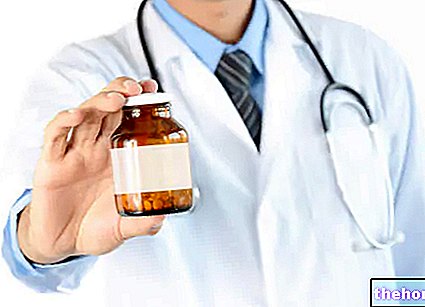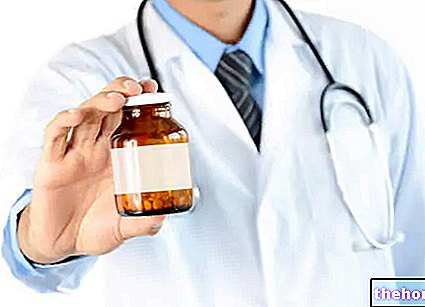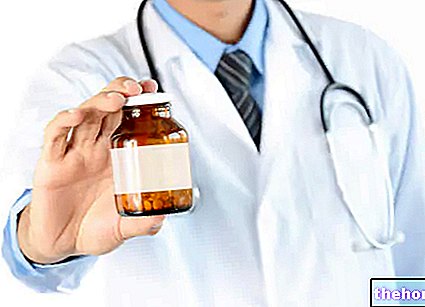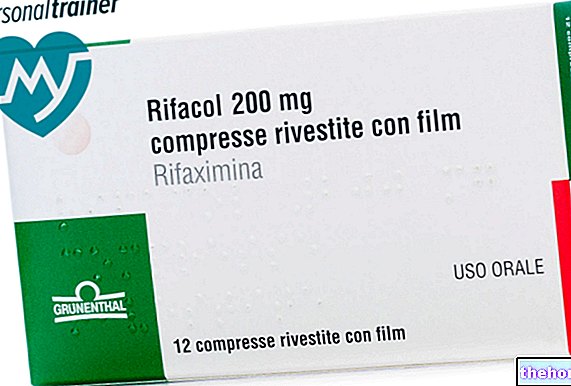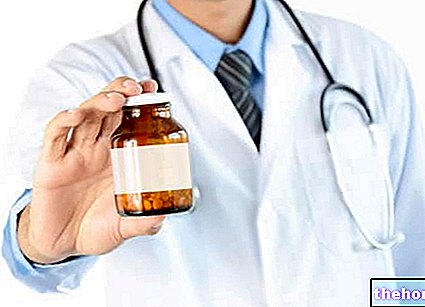Active ingredients: Dextromethorphan
DEXTROMETORPHAN HYBROMIDRATE AFOM 30 mg / 10 ml syrup
DEXTROMETORPHAN HYBROMIDRATE AFOM 15 mg / ml oral drops, solution
Why is Dextromethorphan hydrobromide used - Generic drug? What is it for?
DEXTROMETORPHAN BROMIDRATE AFOM contains the active substance dextromethorphan which belongs to the group of medicines used to treat dry cough.
Talk to your doctor if you don't feel better or if you feel worse after 5 days.
Contraindications When Dextromethorphan hydrobromide should not be used - Generic drug
Do not take DEXTROMETORPHAN HYDROBROMIDRATE AFOM
- if you are allergic to dextromethorphan or any of the other ingredients of this medicine
- if you suffer from breathing problems (bronchial asthma, chronic obstructive pulmonary disease)
- if you have difficulty breathing (including respiratory depression)
- if you have pneumonia, a "lung infection;
- if you suffer from diseases of the blood circulation and heart (cardiovascular disease);
- if you have high blood pressure (hypertension);
- if you suffer from thyroid disorders (hyperthyroidism);
- if you have diabetes;
- if you have an eye disorder (such as glaucoma);
- if you suffer from prostate problems (prostatic hypertrophy);
- if you suffer from stomach, intestinal or urinary tract disorders (such as stenosis of the gastrointestinal and urogenital tract which causes pathological narrowing of the caliber of these organs);
- if you suffer from epilepsy;
- if you have severe liver disease;
- if the patient is a child under the age of 12;
- if you are taking medicines used to treat depression (MAO inhibitor antidepressants);
- if it is just two weeks since "taking the antidepressant medicines (see the section" Other medicines and DEXTROMETORPHAN HYBROMIDRATE AFOM ");
- if you are in the first trimester of pregnancy;
- if you are breast-feeding.
Precautions for use What you need to know before taking Dextromethorphan hydrobromide - Generic drug
Talk to your doctor or pharmacist before taking DEXTROMETORPHAN HYDROBROMIDRATE AFOM.
The duration of treatment with this medicine should not exceed 5-7 days.
The use of DEXTROMETORPHAN HYBROMIDRATE AFOM, especially for prolonged treatments, may cause a decrease in efficacy and the need to continue using the drug (addiction, tolerance, mental and physical dependence). Therefore, a short-term treatment under close medical supervision is recommended, especially if you have a predisposition to manifest this condition.
This medicine is not indicated for the treatment of persistent cough (chronic cough), which may be due to smoking or to lung problems (emphysema) or breathing (asthma). If you have a persistent cough, stop the treatment and contact your doctor, as this may be a symptom of certain breathing disorders (asthma).
If you have a cough accompanied by profuse mucus do not take this medicine. If the cough causes pain and discomfort (irritating cough) and is accompanied by mucus, please contact your doctor who will carefully evaluate the need for treatment with this medicine. If your doctor deems the treatment indispensable, you will need to monitor it during therapy.
Take this medicine with caution and only on medical advice if you also experience fever, skin irritation (rash), headache, nausea and vomiting.
Treatment with DEXTROMETHORPHAN HYBROMIDRATE AFOM can only be started after a "careful evaluation by the doctor and under close supervision if:
- suffer from diseases of the blood circulation and heart (cardiovascular diseases);
- have high blood pressure (hypertension);
- suffer from thyroid disorders (hyperthyroidism);
- have diabetes;
- have an eye disorder (such as glaucoma);
- suffer from prostate problems (prostatic hypertrophy);
- suffer from stomach, intestinal or urinary tract disorders (stenosis of the gastrointestinal and urogenital tract);
- suffer from epilepsy;
- have severe liver disease;
- you are taking medicines used to treat depression (MAO inhibitor antidepressants); before taking DEXTROMETORPHAN HYBROMIDRATE AFOM it is necessary that two weeks have passed since taking the antidepressant medicines.
In all of the above situations, the use of this medicine is not recommended, and is reserved only in cases of absolute necessity (see the section "Do not take DEXTROMETORPHAN HYDROBROMIDRATE AFOM").
For those who carry out sports activities, the use of DEXTROMETORPHAN HYBROMIDRATE AFOM 15 mg / ml oral drops, a solution containing ethanol (ethyl alcohol) can cause positive doping tests in relation to the alcohol concentration limits indicated by some sports federations.
Children and adolescents
The use of this medicine in children under 12 years of age is not recommended.
Interactions Which drugs or foods can modify the effect of Dextromethorphan hydrobromide - Generic drug
Tell your doctor or pharmacist if you are taking, have recently taken or might take any other medicines.
Do not take this medicine if you are taking medicines used to treat depression (MAO inhibitor antidepressants); before taking DEXTROMETORPHAN HYBROMIDRATE AFOM it is necessary that two weeks have passed since taking the antidepressant medicines.
Take special care and talk to your doctor if you are taking:
- medicines used to treat insomnia and anxiety (hypnotic, sedative and anxiolytic medicines);
- medicines used to treat certain heart disorders (amiodarone, quinidine, propafenone);
- medicines used to treat depression (fluoxetine, paroxetine);
- antipsychotic medicines used to treat some mental disorders (haloperidol, thioridazine);
- cimetidine, a medicine used to treat stomach upset due to "high acidity;"
- ritonavir, a medicine used to treat AIDS;
- medicines used to facilitate the elimination of mucus (secretolytic medicines);
- antidepressant medicines (MAO inhibitor antidepressants);
- linezolid, a medicine used to treat infections caused by bacteria;
- sibutramine, a medicine used to treat obesity.
MAO inhibitory antidepressants, linezolid and sibutramine when taken simultaneously with DEXTROMETORPHAN HYBROMIDRATE AFOM can cause a condition, which can be fatal, called "serotonin syndrome" whose symptoms are:
- nausea;
- decrease in blood pressure (hypotension);
- tremors, disturbances, convulsions and involuntary contractions and distension of the muscles (clonic spasm, myoclonus, increased reflex response and stiffness of pyramidal origin);
- nervous system disorders such as hyperactivity, fever, rapid heartbeat (tachycardia), shortness of breath (tachypnea), pupil dilation (mydriasis);
- profuse sweating (diaphoresis);
- mental disorders (agitation, excitement, confusion);
- heart block (cardiac arrest) and death.
DEXTROMETORPHAN HYBROMIDRATE AFOM with drinks and alcohol
Avoid taking grapefruit juice during treatment with this medicine as it may increase the toxic effects and decrease the effect of the medicine. Avoid drinking alcohol while taking this medicine.
Warnings It is important to know that:
Pregnancy and breastfeeding
If you are pregnant or breast-feeding, think you may be pregnant or are planning to have a baby, ask your doctor or pharmacist for advice before taking this medicine. Do not take this medicine in the first three months of pregnancy. After the third month of pregnancy you can only take this medicine in cases of absolute necessity and under close medical supervision because breathing problems in the newborn (respiratory depression) may occur, especially at high doses and even for short periods of treatment.
Do not take this medicine while breastfeeding, as a respiratory depressive effect in the newborn cannot be ruled out.
DEXTROMETORPHAN HYBROMIDRATE AFOM is not indicated during lactation.
Driving and using machines
DEXTROMETORPHAN HYDROBROMIDRATE AFOM may affect the ability to drive or use machines, as it can make you drowsy, especially if you drink alcohol at the same time (see section "DEXTROMETORPHAN BROMIDRATE AFOM with drinks and alcohol").
DEXTROMETORPHAN HYBROMIDRATE AFOM 30 mg / 10 ml syrup contains sucrose and parahydroxybenzoates
This medicine contains sucrose, a type of sugar. If you have been diagnosed by your doctor with diabetes, or have an intolerance to some sugars, or are following a weight loss diet, contact your doctor before taking this medicinal product.
This medicine contains antimicrobial preservatives such as sodium benzoate and parahydroxybenzoates (methyl parahydroxybenzoate, ethyl parahydroxybenzoate, propyl parahydroxybenzoate) which can cause allergic reactions, even delayed.
DEXTROMETORPHAN HYBROMIDRATE AFOM 15 mg / ml oral drops, solution contains ethanol
This medicine contains small amounts of ethanol (ethyl alcohol) less than 100 mg per dose.
For those who carry out sporting activities, the use of medicines containing ethyl alcohol can determine positive doping tests in relation to the alcohol concentration limits indicated by some sports federations.
The container of this medicine is made of latex rubber, which can cause severe allergic reactions.
Dose, Method and Time of Administration How to use Dextromethorphan hydrobromide - Generic drug: Posology
Always take this medicine exactly as described in this leaflet or as directed by your doctor or pharmacist. If in doubt, consult your doctor or pharmacist.
DEXTROMETORPHAN HYBROMIDRATE AFOM 30 mg / 10 ml syrup
To open the bottle, press and unscrew at the same time.
In adults and adolescents (12 to 18 years), the recommended dose ranges from 10 mg of dextromethorphan (an amount equal to one teaspoon of syrup, which corresponds to approximately 3 ml) to 20 mg of dextromethorphan (equal to 2 teaspoons of syrup, which corresponds to 6 ml), every 6 hours.
The maximum recommended dose per day is 80 mg of dextromethorphan (equivalent to 8 teaspoons of syrup per day). To close the bottle screw tightly by pressing.
DEXTROMETORPHAN HYBROMIDRATE AFOM 15 mg / ml oral drops, solution
To open the dropper bottle, press and unscrew at the same time
In adults and adolescents (12 to 18 years), the recommended dose ranges from 10 mg of dextromethorphan (equivalent to approximately 14 drops) to 20 mg (equivalent to approximately 28 drops), every 6 hours.
The maximum recommended dose per day is 80 mg of dextromethorphan (approximately 110 drops per day).
If you forget to take DEXTROMETORPHAN HYDROBROMIDRATE AFOM
Do not take a double dose to make up for a forgotten dose.
If you stop taking dextromethorphan hydrobromide AFOM
If you have any further questions on the use of this medicine, ask your doctor or pharmacist.
Overdose What to do if you have taken an overdose of Dextromethorphan hydrobromide - Generic drug
If you take more DEXTROMETORPHAN HYDROBROMIDRATE AFOM than you should In case of an overdose the symptoms may be:
- nausea, vomiting;
- vision disturbances;
- movement coordination disorders (ataxia);
- dizziness;
- excitement, mental confusion;
- muscle disorders (increased muscle tone);
- decrease in blood pressure (hypotension);
- increased heart rate (tachycardia);
- decreased urine output and breathing problems (respiratory depression) in severe cases.
If you have swallowed / taken too much of this medicine, notify your doctor immediately or go to the nearest hospital. If necessary, gastric lavage is recommended.
Side Effects What are the side effects of Dextromethorphan hydrobromide - Generic drug
Like all medicines, this medicine can cause side effects, although not everybody gets them.
The frequency of undesirable effects is unknown (i.e. cannot be estimated from the available data). The individual side effects are listed below:
- drowsiness, fatigue;
- involuntary and rapid movements of the eye (nystagmus);
- difficulty moving (dystonia);
- dizziness
- mental confusion and behavioral changes (bad language);
- mental disorders (psychosis), hallucinations;
- need to continue taking the medicine (psychic dependence);
- severe allergic (anaphylactic) reactions and anaphylactoid reactions (similar to anaphylactic reactions, but less severe);
- even very high fever;
- diabetes mellitus;
- nausea and vomit;
- stomach and intestinal disorders, decreased appetite;
- allergic skin reactions (rashes);
- "serotonin syndrome", characterized by nausea, decreased blood pressure (hypotension), tremors, disturbances, convulsions and involuntary contractions and distension of the muscles (clonic spasm, myoclonus, increased reflex response and stiffness of pyramidal origin), system disorders nervous system such as hyperactivity, fever, rapid heartbeat (tachycardia), shortness of breath (tachypnea), dilation of the pupil (mydriasis), profuse sweating (diaphoresis), mental disorders (agitation, excitement, confusion), up to the block of the heart (cardiac arrest) and death.
Compliance with the instructions contained in the package leaflet reduces the risk of undesirable effects.
Reporting of side effects
If you get any side effects, talk to your doctor or pharmacist. This includes any possible side effects not listed in this leaflet. You can also report side effects directly via the national reporting system at www.agenziafarmaco.it/it/responsabili. By reporting side effects you can help provide more information on the safety of this medicine.
Expiry and Retention
Keep this medicine out of the sight and reach of children. Do not use this medicine after the expiry date which is stated on the package after "EXP". The expiry date refers to the last day of that month.
Keep the medicine in the original package in order to protect it from light.
Do not throw any medicines via wastewater or household waste. Ask your pharmacist how to throw away medicines you no longer use. This will help protect the environment.
Other Information
What DEXTROMETORPHAN HYDROBROMIDRATE AFOM contains
DEXTROMETORPHAN HYBROMIDRATE AFOM 30 mg / 10 ml syrup
- The active ingredient is dextromethorphan hydrobromide. Each 10 ml of syrup contains 30 mg of dextromethorphan hydrobromide.
- The other ingredients are: sucrose, sodium benzoate and parahydroxybenzoates (methyl parahydroxybenzoate, ethyl parahydroxybenzoate, propyl parahydroxybenzoate (which can cause allergic reactions, even if delayed), sodium hydroxide, propylene glycol, peppermint essential oil, citric acid, cedar flavor, water purified. (see paragraph "Driving and using machines")
DEXTROMETORPHAN HYBROMIDRATE AFOM 15 mg / ml oral drops, solution
- The active ingredient is dextromethorphan hydrobromide. Each ml of solution contains 15 mg of dextromethorphan hydrobromide.
- The other ingredients are: ethanol (ethyl alcohol), peppermint essential oil, purified water.
- This medicine contains small amounts of ethanol (ethyl alcohol) less than 100 mg per dose.
- The container of this medicine is made of latex rubber, which can cause severe allergic reactions.
Description of the appearance of DEXTROMETORPHAN HYBROMIDRATE AFOM and contents of the pack
DEXTROMETORPHAN HYBROMIDRATE AFOM 30 mg / 10 ml syrup
Pack containing a 150 ml glass bottle.
DEXTROMETORPHAN HYBROMIDRATE AFOM 15 mg / ml oral drops, solution
Pack containing a glass bottle with dropper of 20 ml of solution.
Source Package Leaflet: AIFA (Italian Medicines Agency). Content published in January 2016. The information present may not be up-to-date.
To have access to the most up-to-date version, it is advisable to access the AIFA (Italian Medicines Agency) website. Disclaimer and useful information.
01.0 NAME OF THE MEDICINAL PRODUCT
DEXTROMETORPHAN HYBROMIDRATE AFOM
02.0 QUALITATIVE AND QUANTITATIVE COMPOSITION
Syrup: 10 ml of syrup contain
Active ingredient: dextromethorphan hydrobromide 30 mg.
Oral drops, solution : 1 ml of solution contains
Active ingredient: dextromethorphan hydrobromide 15 mg.
For the full list of excipients, see section 6.1.
03.0 PHARMACEUTICAL FORM
Syrup; oral drops, solution.
04.0 CLINICAL INFORMATION
04.1 Therapeutic indications
Dextromethorphan hydrobromide is indicated for the symptomatic treatment of dry cough.
04.2 Posology and method of administration
Adults and adolescents (12 to 18 years)
Syrup
The generally recommended dose range varies from 10 mg (one teaspoon corresponding to approximately 3 ml) to 20 mg (2 teaspoons corresponding to approximately 6 ml in total) every 6 hours.
The maximum dose achievable in 24 hours is 80 mg.
Oral drops, solution
The generally recommended dose range is 10 mg (approximately 14 drops) to 20 mg (approximately 28 drops) every 6 hours.
The maximum dose that can be reached in 24 hours is 80 mg (about 110 drops).
Children up to 12 years
Dextromethorphan hydrobromide should not be used.
04.3 Contraindications
- Hypersensitivity to the active substance or to any of the excipients;
- bronchial asthma, COPD (chronic obstructive pulmonary disease), pneumonia, breathing difficulties, respiratory depression;
- cardiovascular diseases, hypertension;
- hyperthyroidism;
- diabetes;
- glaucoma;
- prostatic hypertrophy;
- stenosis of the gastrointestinal and urogenital systems;
- epilepsy;
- severe liver disease;
- children under the age of 12;
- do not use at the same time or in the two weeks following MAO inhibiting antidepressant drugs;
- first trimester of pregnancy, lactation (see section 4.6).
04.4 Special warnings and appropriate precautions for use
Treatment with dextromethorphan hydrobromide should not be continued beyond 5-7 days. If there is no therapeutic response within a few days, the physician should re-evaluate the situation.
Dextromethorphan hydrobromide can be addictive. Following prolonged use, patients may develop tolerance to the medicinal product, as well as mental and physical dependence (see section 4.8). Patients with a tendency to abuse or dependence should take dextromethorphan hydrobromide syrup for short periods and under close medical supervision.
A chronic cough can be an early symptom of asthma and therefore dextromethorphan hydrobromide is not indicated for the suppression of chronic or persistent cough (e.g. due to smoking, emphysema, asthma, etc.).
Dextromethorphan hydrobromide should be administered with particular caution and only on medical advice if the cough is accompanied by other symptoms such as: fever, rash, headache, nausea and vomiting.
The medicine should not be taken in case of cough accompanied by profuse secretion. In the event of an irritating cough with considerable mucus production, treatment with dextromethorphan hydrobromide should be administered with particular caution and only on medical advice after a "careful risk-benefit assessment.
The use of alcohol is not recommended during therapy with dextromethorphan hydrobromide (see section 4.5).
Administer with caution and only after a careful risk-benefit assessment of dextromethorphan hydrobromide in patients with cardiovascular disease, hypertension, hyperthyroidism, diabetes, glaucoma, prostatic hypertrophy, stenosis of the gastrointestinal and urogenital tract, epilepsy, impaired liver function. in people with or who are taking antidepressant drugs, such as MAO inhibitor drugs.
Important information about some of the ingredients:
Syrup: contains sucrose: this should be taken into account in diabetic patients and in patients who follow low-calorie diets. 10 ml of syrup contains 5 g of sucrose; it also contains parahydroxybenzoates (Stabilan); these substances can cause, in some subjects, allergic reactions which can be of a delayed type.
Oral drops, solution: contain small amounts of ethanol (ethyl alcohol), less than 100 mg per dose. For those who carry out sports activities, the use of medicines containing ethyl alcohol can determine a positive anti-doping test in relation to the alcohol concentration limits indicated by some sports federations. The container of this medicine is made of latex rubber. It can cause severe allergic reactions
04.5 Interactions with other medicinal products and other forms of interaction
MAO inhibitor drugs
Concomitant administration of dextromethorphan hydrobromide with MAO inhibitor drugs is contraindicated.
Also, dextromethorphan hydrobromide syrup should not be taken for 2 weeks following MAO inhibitor therapy. The association of these drugs can, in fact, induce the development of a serotonin syndrome characterized by the following symptoms: nausea, hypotension, neuromuscular hyperactivity (tremor, clonic spasm, myoclonus, increased reflex response and stiffness of pyramidal origin), hyperactivity of the autonomic nervous system (diaphoresis, fever, tachycardia, tachypnea, mydriasis) and altered mental state (agitation, excitement, confusion), up to cardiac arrest and death.
Linezolid and sibutramine
Cases of serotonin syndrome have also been reported following concomitant administration of dextromethorphan hydrobromide with linezolid or with sibutramine.
Central nervous system inhibitory drugs
The concomitant administration of dextromethorphan hydrobromide with drugs with an inhibitory effect on the central nervous system such as hypnotics, sedatives or anxiolytics, or with the intake of alcohol, can lead to additive effects on the central nervous system.
Cytochrome P450-2D6 inhibitor drugs
The concomitant administration of dextromethorphan hydrobromide with drugs that inhibit the enzymatic activity of cytochrome P450-2D6 in the liver, and therefore, the metabolism of dextromethorphan, can lead to an increase in the plasma concentration of dextromethorphan with consequent increase in its toxicity. Considering that this effect may occur even if the cytochrome P450-2D6 inhibitor drug has been taken recently and not necessarily at the same time as the dextromethorphan hydrobromide syrup. The main drugs that inhibit cytochrome P450-2D6 are: amiodarone, quinidine, fluoxetine, haloperidol, paroxetine, propafenone, thioridazine, cimetidine and ritonavir.
Secretolytic drugs
If dextromethorphan hydrobromide is used in combination with secretolytic drugs, the reduced cough reflex can lead to severe mucus accumulation.
Grapefruit juice
Grapefruit juice can increase the absorption, bioavailability and elimination of dextromethorphan hydrobromide, resulting in increased toxicity and decreased effect.
04.6 Pregnancy and breastfeeding
The results of epidemiological studies on a limited sample of the population did not indicate an increase in the frequency of malformations in children who were exposed to dextromethorphan hydrobromide during the prenatal period. However, these studies do not adequately document the period and duration of treatment with dextromethorphan hydrobromide.
Reproductive toxicity studies in animals do not indicate a potential risk to humans for dextromethorphan hydrobromide (see section 5.3).
Dextromethorphan hydrobromide should not be used during the first three months of pregnancy; moreover, since the administration of high doses of dextromethorphan hydrobromide, even for short periods, can cause respiratory depression in newborns, in the following months the drug must be administered only in case of real need and after a "careful evaluation of the benefits and risks. Since excretion of the drug in breast milk is not known and a respiratory depressive effect on the newborn cannot be excluded, dextromethorphan hydrobromide is contraindicated during lactation.
04.7 Effects on ability to drive and use machines
Dextromethorphan hydrobromide can affect the ability to drive or use machines, as it can induce drowsiness. This effect is accentuated in the case of simultaneous alcohol intake (see section 4.5).
04.8 Undesirable effects
The following are the undesirable effects of dextromethorphan hydrobromide organized according to the MedDRA system organ class. Insufficient data are available to establish the frequency of all single effects listed.
Nervous system disorders
Somnolence, fatigue, nystagmus, dystonia, dizziness, mental light-headedness and bad language.
Serotonin syndrome, characterized by: nausea, hypotension, neuromuscular hyperactivity (tremor, clonic spasm, myoclonus, increased reflex response and stiffness of pyramidal origin), hyperactivity of the autonomic nervous system (diaphoresis, fever, tachycardia, tachypnea, mydriasis) and mental status altered (agitation, excitement, confusion), up to cardiac arrest and death.
Psychiatric disorders
Psychosis, hallucinations. Psychic dependence; dextromethorphan has a low risk of abuse and dependence. However, there have been reports of psychic (non-physical) dependence and cases of abuse due to the euphoric effect caused by the substance.
Disorders of the immune system
Anaphylactic and anaphylactoid reactions.
General disorders and administration site conditions
Hyperpyrexia and hyperthermia.
Metabolism and nutrition disorders
Diabetes mellitus.
Gastrointestinal disorders
Nausea, vomiting, gastrointestinal disturbances and reduced appetite.
Skin and subcutaneous tissue disorders
Allergic skin reactions and rashes.
04.9 Overdose
Symptoms
Nausea, vomiting, visual disturbances and central nervous system disorders such as ataxia, dizziness, arousal, increased muscle tone, mental confusion, hypotension and tachycardia.
In extreme cases, urinary retention and respiratory depression can occur.
Therapy
If necessary, seek intensive medical care (in particular intubation, ventilation). It may be necessary to take precautions to safeguard heat loss and replenish fluids. Intravenous administration of naloxone may antagonize the effects of dextromethorphan hydrobromide on the central nervous system, particularly respiratory depression.
If necessary, gastric lavage is recommended.
Do not administer centrally acting emetics.
05.0 PHARMACOLOGICAL PROPERTIES
05.1 Pharmacodynamic properties
Pharmacotherapeutic group: cough suppressant.
ATC code: R05DA09.
Dextromethorphan hydrobromide is the dextrorotatory stereoisomer of 3-methoxy levorphanol, an opioid substance.
It has a "depressant action on the medullary centers of cough, causing an increase in the threshold of onset. Therefore, dextromethorphan hydrobromide has a" central antitussive action. At the recommended doses it does not possess the typical properties of opioid substances, such as: analgesia, respiratory depression, dependence and tolerance.
05.2 Pharmacokinetic properties
Absorption
Dextromethorphan hydrobromide is rapidly absorbed from the gastrointestinal tract after oral administration.
The peak plasma concentration is reached in 2 hours. Its action occurs in 0.5-1 hour after administration and lasts for about six hours.
Distribution
Animal studies have shown that dextromethorphan hydrobromide is taken up and concentrated in cortical tissues.
Metabolism
Dextromethorphan hydrobromide is metabolised in the liver (first pass effect). The main metabolic steps are O- oxidation and N- demethylation, mediated by CYP3A and CYP2D6, and subsequent conjugation. The main active metabolite is dextrorphan, which has a modest antitussive activity. Other metabolites are 3-methoxymorphine. and 3-hydroxymorphine.
Since CYP2D6 is a polymorphic enzyme, the metabolism of dextromethorphan depends on the genotype of the individuals.
The frequency of the phenotype showing reduced CYP 2D6 activity varies between different ethnic groups from 1 to 10%.
Elimination
Dextromethorphan hydrobromide is excreted primarily as an unchanged molecule or as various demethylated metabolites by the kidneys. Less than 1% is eliminated in the faeces.
The plasma elimination half-life is normally between 1 and 2 hours. This period may extend up to 45 hours if abnormal CYP2D6 metabolism is involved.
05.3 Preclinical safety data
Chronic and subchronic toxicity
Studies of chronic and subchronic toxicity, with repeated administration, carried out in dogs and rats did not reveal any toxic effects induced by the drug.
Mutagenic and oncogenic potential
Dextromethorphan hydrobromide has not been adequately studied for its mutagenic potential. The Ames test was negative, therefore the mutagenic potential cannot be adequately assessed. Long-term animal studies have not been conducted to determine oncogenic potential.
Reproductive toxicity
Studies were conducted to evaluate the toxic effects of dextromethorphan hydrobromide on the reproductive capacity of rats and rabbits. The fertility of rats (male and female) was not affected by administering doses of 50 mg / kg / body weight per day. Embryos of rats and young animals showed no undesirable effects attributable to the drug. Dextromethorphan hydrobromide has no embryotoxic effects in rats at doses of 50 mg / kg per body weight per day.
In contrast, a study conducted on chicken embryos found that dextromethorphan hydrobromide was lethal for more than half of the exposed embryos and caused malformations in 16% of surviving chicks.
The main malformations detected involved the neural crest and the neural tube. However, it is unclear whether such findings may have any relevance to human pregnancy, due to the numerous differences between mammalian gestation and the closed system consisting of a chicken egg.
06.0 PHARMACEUTICAL INFORMATION
06.1 Excipients
Syrup: sucrose, stabilan, peppermint essential oil, citric acid, cedar flavor, purified water.
Oral drops, solution: ethanol, peppermint essential oil, purified water.
06.2 Incompatibility
Not relevant.
06.3 Period of validity
Syrup: 60 months.
Oral drops, solution: 60 months.
06.4 Special precautions for storage
Store in the original package to protect the medicine from light.
06.5 Nature of the immediate packaging and contents of the package
Syrup: glass bottle containing 150 ml of solution.
Oral drops, solution: glass bottle with dropper containing 20 ml of solution.
06.6 Instructions for use and handling
To open the bottle press and at the same time turn, to close screw tightly by pressing. No special instructions for handling. Unused medicine and waste derived from this medicine must be disposed of in accordance with local regulations.
07.0 MARKETING AUTHORIZATION HOLDER
AEFFE FARMACEUTICI Srl
Piazza Sant "Angelo 1- Milan
Sales dealer:
Montefarmaco OTC Spa
Via IV Novembre, 92 - 20021 Bollate (MI)
08.0 MARKETING AUTHORIZATION NUMBER
Syrup: AIC n. 029902020
Oral drops, solution: AIC n. 029902032
09.0 DATE OF FIRST AUTHORIZATION OR RENEWAL OF THE AUTHORIZATION
Date of first authorization: 17/12/1993
Date of the last Renewal of the Authorization: 16/06/2008

